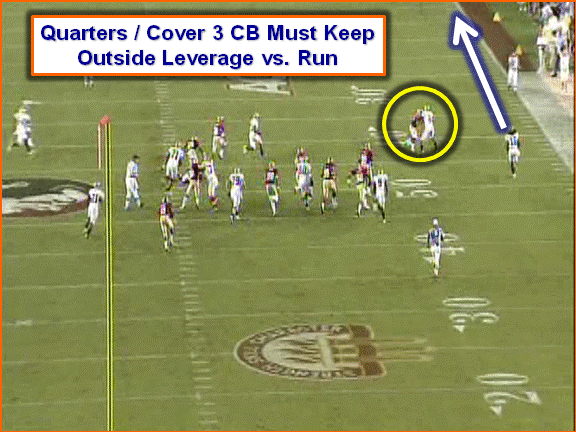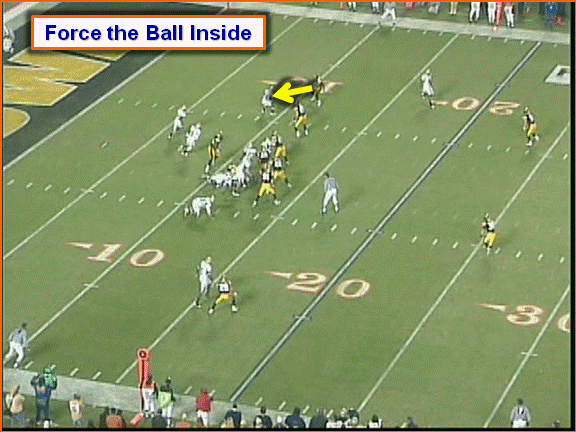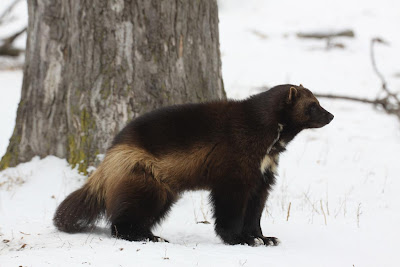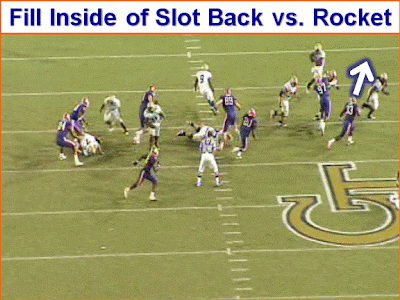Introduction
The OLB position vs. the Flexbone has a lot of keys and reads compared to other positions in the 4-3 Defense, so I got a great coach to explain it. My next guest writer is a man who needs no introduction. He is an outstanding football coach that has taught me a ton about football and technology over the years. He is the author of one of the best articles written on defense (here), and he has the best football coaching blog on the Internet (here). His site has more posts than days of the year and they contain a wealth of information for fellow football coaches. Let me introduce the one and only Brophy...
Stopping Option, much less Flexbone, requires an entire team performance; no part is greater than the sum. Each position must function together within the supporting framework of the front and coverage. The Option attack will stress a defense’s fundamentals; therefore, there must be clearly defined assignments of Dive (FB), Quarterback, and Pitch, with disciplined backside gap support.
With the other front positions expertly covered by the other coaches, I will provide an overview of preparing the Outside Linebacker against the Flexbone Option offense. The ‘easy’ part of this equation for the Outside Linebacker is that he is supported and protected by the coverage. With a 2-high shell, he is afforded the luxury of being a perimeter defender without being the Force player. The 7 man box of the 4-3 means that the Corner will be force in Cover 2, the Safety will be Force in Cover 4, or if indeed, the Outside Linebacker is the Force player it will be against the weak side of the offensive formation (no Tight End) and be some type of Quarter-Halves variation (coverage rolled away from this backer). This allows him to be free from interior fast-read trash (allow him to process the offense response) and position himself for leverage for block destruction.
By not acting as the Force player, the Linebacker isn’t pressured with the ‘don’t get reached’ mantra and is allowed to be more aggressive in attacking the ball and blocks. The area of importance for the Outside Linebacker will be flow-to C gap and flow away A gap (strong) or D gap and B gap weak respectively. This short-area focus allows him to efficiently act as a fulcrum between the Force defender and the interior mass of the front.
WIN - WHAT'S IMPORTANT NOW?
What do you have to stop against the Flexbone and how does it relate to the role of the Outside Linebacker? The focus of this series has been about stopping the Option with the 4-3, so we will begin there. However, the drills and training used for this will also support the complimentary plays of Flexbone: Power, Buck, and Counter.
The immediate threat to the Outside Linebacker’s position is the Outside Veer or Quarterback-to-Alley phase of the Option. To reduce the focus and create confidence in assignment, the Outside Linebacker should be trained to react to the initial steps of the end man on the line of scrimmage (EMOL), coupled with the nearside Wing.
This training is done with respect to provide the player with focus and avoid succumbing to a “
looming effect” due to the bone’s heavy use of misdirection and pre-snap motioning of Backs. I will reiterate the importance of stressing this player to think of himself as a short-area player, this way his movement is deliberate and efficient for leveraging the ball.
With each bread-and-butter play you will generally get a consistent picture provided to the defense. The movements the Linebacker should be proficient in identifying and correctly stepping with are:
Wing Motion TO (the Linebacker)
If the Wing remains to the side of the Linebacker, he usually will be involved in blocking the perimeter on runs (or twirl motion back inside for Iso). He should assume he will be threatened immediately and fast-read the EMOL’s first step and pad level.
Wing Motion AWAY (from the Linebacker)
With Wing motioning away from the Linebacker, he can condition himself to slow-play his reads, as in most situations the offensive play side will be away from the Backer. With Wing motion away, it is easy for the offense to lull the Linebacker into a trance with the orbit motion, thinking that anytime the Wing motions, the play will be away from the Backer. This is why we want to drill the Linebacker into making the ‘robotic’ 2-step shuffle into B gap (looking to A) to not position himself out of supporting a weakside / Counter run. You will see in the Iowa clips vs. Georgia Tech, the Outside Linebackers executing this dogmatically ensuring they are always in position to make a play. With motion away, his eyes should immediately snap to the EMOL.
Reading the EMOL
· - TURN-OUT / BASE
- DOWN
- ARC / REACH
·
TURN-OUT / BASE - If the EMOL quickly steps inside and turns his head (see his earhole) to get inside the Defensive End…with a Fullback moving inside or away, the Backer should 2-step shuffle (remaining square the line of scrimmage) and fit himself into his interior (backside) gap support. He will also 2-step shuffle and fit inside if he sees the EMOL base block the Defensive End.
To the playside vs. Zone Dive, the NT has the A gap, the Mike and OLB both have the B gap, the DE has the C gap, and the Safety is the Force player and he has the D gap. The OLB Fits on the Outside Half of the B Gap to allow the Mike LB to come free and make the tackle:
DOWN - If the EMOL blocks down hard with low pad level (can’t see the earholes) to wash down inside (down on 5 tech or TO the backer)….with a Fullback moving toward the Linebacker, the offense is setting up Power/Counter (the Wing motion really helps this out). If the 9 tech DE is being loaded on, the Tight End will come down inside to get on top of the Linebacker. The Linebacker should see this and attack it much like he would against an Isolation block, engage with the inside flipper and shed into the C gap.
ARC / REACH - If the EMOL (TE) flattens his release outside, and Fullback heads towards the Linebacker, he will likely be heading upfield to block the Safety and/or Corner (depending if there is a crack block by the Corner) on an arc release. The arc or reach block is a dead give-away to outside run-action. The Linebacker should not be in a rush to get outside of the Tight End here, though (remember, he isn’t Force in C2/C4), but should maintain leverage on a leading fullback and/or a reaching tackle. The Linebacker will want to spill the runner outside of him, therefore it is essential that he maintains leverage on the blocker while pressing the LOS until the runner clears. The premise here is to string the runner outside to support and not allow him to cutback, maintaining enough position to still make the tackle on the ball carrier.
These looks can all be presented at a high rate of speed, and should simply just be 2-3 step reactions to the EMOL movements. It is important that you reiterate the purpose of the drill (to give a conditioning look to build confidence in the linebacker’s assignment), to ensure the defender gains assurance in his responsibility and reinforce his ability to identify what is presented to him. The ‘scout’ looks given should be exaggerated to make the identification simple (players will attempt to ‘trick’ each other with looks, which is counter-productive to drilling a response).
DRILLS
The simplest way to train the Outside Linebacker for the type of looks he will see against the Flexbone is through constant repetition against EMOL first steps. During Individual / Pre-Practice periods, the Outside Linebacker should rep. Using the same looks you used above from Pre-Practice / INDY, you can bring the exact same looks to a bigger picture, working all Linebackers at once to provide a complete picture of offensive looks and gap support.
You can put this altogether (with the entire Linebacker corps and/or Safeties, too) with the IN-AT-OUT drill. Using this drill to represent the Bone, you really only need the relevant pieces, which would be the 3 Backs and 2 EMOL (2 TEs or 1 TE + 1 OT). The offensive players can be scout defenders (backups) and just given play cards to quickly rep the motion and action to emulate.
The drill is credited to Jeff Walker, author of “Coaching the 40 Nickel Defense” (who now runs a 33 defense). It is simple and effective, just set up the ball and appropriate landmarks / necessary offensive players as needed. The necessary components are the Wings, Fullback, and EMOL; these are the only players needed to provide the looks for the linebacking corps. The action presented will only attack 1 of the 3 areas. The Linebackers should then appropriately step-react to the looks given, and end up in their gap fit. This can be a full-speed or a ¾ speed drill. Tackling isn’t what is being reinforced here, it is proper footwork and leverage. When repping the 1-step reactions, you want to ensure your defenders are using correct movements, with this drills you should be hammering away at your players to be in the correct (gap-fit) leverage position. Never forget that this is a muscle-memory exercise. I should note that the success of this drill will depend on how mature your Linebackers are. Use the minimal amount of stimuli possible and add offensive players as your Linebackers become more proficient. Starting out, you could actually just use a Fullback (path) as the reactionary stimulus (if Fullback takes this path, fit here….if Fullback takes this path, go here). You want the end product being your Linebackers being able to key off a pattern and not fixating on one player (i.e. the Wings).
With the Triple Option, the look is provided in the graphic below to give you an idea how this works. Once the EMOL steps down inside, the Fullback veers toward the AT gap, the SLB would squeeze down to fit into the Quarterback-to-Pitch relationship on the option. With the backside Wing orbiting away from the WLB, he should execute the backside shuffle technique. This provides continual reinforcement of the 1-on-1 drills you used earlier to bolster the confidence of the Linebacker. The entire picture will be supplied during your TEAM periods.
With a Midline look, the Linebacker would be given an set block by the EMOL with the Wing heading inside, the Fullback attacking the cylinder of the A gap. Since Fullback is IN, the near Wing is IN, the Linebacker would execute his backside 2-step shuffle technique and look to maintain his outside shoulder free, squeezing parallel to the line of scrimmage.
As an addition, the Outside Veer will present itself similar to the Triple, with the Fullback attacking the AT and the Wing arcing.
With Speed Option, the reach block is presented by the EMOL with the Wing arcing reaching with the EMOL. It is important here for the SLB to not give ground, to attack the Wing with his inside arm (engage the blocker first), and explode his hips to separate when the Quarterback appears. It isn’t important if the SLB makes the tackle here, if he forces the Pitch within 2 seconds (and forcing the ball into an area he is not responsible for; “OUT”) he has ‘done his job’. Again, reinforce the short-area premise we spoke of before.
With the extreme reach block presented by the backside EMOL and the Wing in motion, the WLB here should “get width/ get depth” as he is now in a backside support role. He movement should be gaining depth while squeezing inside to the ball, in a steady, parallel shuffle , but never cross the A gap.
This type of ‘controlled vignette’ environment helps tremendously overcome the distraction of multiple moving parts your players will see prior to TEAM practice against the scout offense. Building your players reps piece-by-piece, in digestible amounts is essential to build a TEAM defense approach against an attack as complete as Flexbone.
CONCLUSION
I have provided a basic overview for developing your Linebackers to face the Flexbone Option attack. The simplicity of the Bone is part of its charm and sophistication. With a few base plays, Flexbone offenses typically adapt new wrinkles and blocking adjustments that run counter to how an opponent would actually defend them (adjusting who the read defender will be; blocking the same play 5 different ways). As such, it is important for the defensive staff to thoroughly game plan and appropriately rep the looks the specific opponent will give. You may have to face 2 or 3 Flexbone offenses in a season, yet prepare for each in a different fashion.
Good luck next season!
3. Unless Slot Folds Inside, You Don't Need to Fill B gap When You are to 3 Tech Side
5. Coming in Too Far vs. Twirl Motion
6. Not Keeping Outside Leverage vs. TE
7. Must Fit Outside of TE Fold Block Like You Would vs. a Slot
Sat. January 15 - DE Play
Wed. January 19 - Mike Play
Sat. January 22 - OLB Play
Wed. January 26 - FS/SS Play



















































